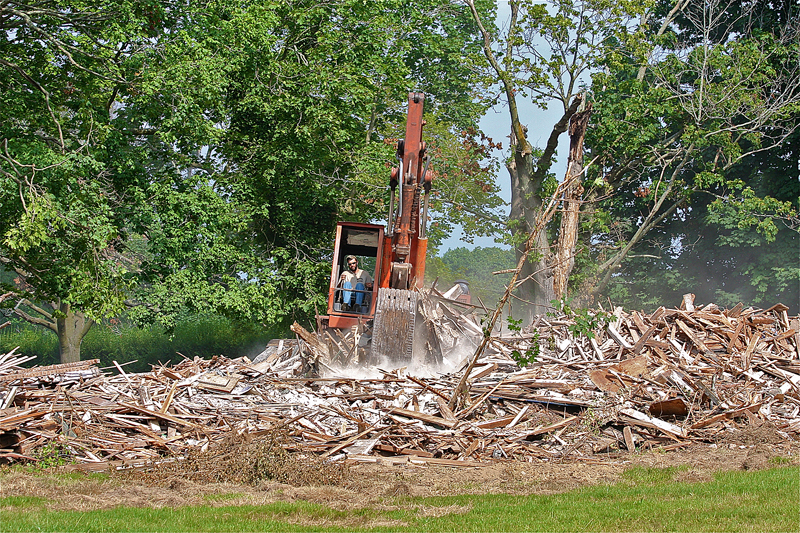Historic house on Main Road in Aquebogue demolished

Main Road bid a sad farewell to a piece of its history over the weekend.
Owners began to demolish a famous Gothic house at 591 Main Road in Aquebogue Saturday to make way for a new home.
The long-vacant home was built by local carpenter John Elliot Aldrich around 1870, and has been owned by the Corwin family as part of their duck farm since the 1950s.
In place of the historic house, Blake Corwin will build a home for his growing family.
“It’s hard to see it gone,” he said. “It was a landmark in some ways, but you’ve got to make the decision: Do you want to sit and look at something that’s costing you money, or move forward?”
With its Gothic-Italianate features, the historic house stood out from its modest neighbors as an advertisement that Aldrich was a “master builder,” said Richard Wines, chair of the Riverhead Landmarks Preservation Commission.
It was never an official town landmark, but it was easily recognizable by many. But in recent years, it had fallen into disrepair.
Before its demolition, the Aldrich house sat vacant for 11 years because it was hazardous and uninhabitable. Among its problems were a roof riddled with holes, substantial water damage and a “mountain” of raccoon feces on the floor.
A 2005 News-Review story described it as “ominous.”
“It was in a horrible state of disrepair, and it would have cost us multiple millions of dollars to repair it, which is a shame,” said Doug Corwin, Blake’s father. “We’d love to have rebuilt, but it became totally impractical.”

Blake Corwin lives across the street from the property with his wife and two daughters. A third child “may be on the way,” he said, so he had to choose between expanding his home now or building a new residence where the abandoned house stands.
Mr. Corwin said his children would have to cross Route 25 to get onto the family farm and visit their grandparents if he were he to expand his current home. So to ensure their safety and comfort, he made the tough decision to demolish the house and replace it with a newly built two-story, four-bedroom house.
Mr. Corwin said he kept some doorknobs and wood from the 1870 house. He hopes to find a use for them in the new home.
“I’m trying to preserve the first floor itself to see if the beams were worth anything,” he said.
The Corwins had previously worked with Mr. Wines to explore strategies to preserve the house, focusing on a potential long-term lease since the family did not want to sell the property.
“The Corwin family did what they could to keep it going, and we certainly thank them for that,” Mr. Wines said. “It’s always sad to see a house like that go.”
But with so many issues, it became infeasible for the Corwins to restore the property themselves — a project that would have cost millions of dollars, Mr. Corwin said.
“We’re not millionaires, we’re duck farmers,” Blake said.
In 2012, the Landmarks Preservation Commission wrote a proposition to have a six-mile portion of Main Road that included the house registered as a historic district. That effort failed two-and-a-half years later after meeting opposition from local residents.
Mr. Wines said the Aldrich house would not have been automatically saved from demolition were it part of a historic district. However, the district would have allowed anyone looking to renovate the property to have 40 percent of the project paid for by federal and state tax credits.
“Of course we’re sad to see [the house] go,” Mr. Wines said. “This is one of the reasons the landmarks commission worked for two-and-a-half years to try and set up a nationally registered historic district.”
Now, Mr. Wines is galvanized by the loss and hopes for greater success in protecting other historic houses along Main Road.
“We’re going to miss it, but I think we need to take this as a wake-up call,” he said.
Photo credits: Barbaraellen Koch



